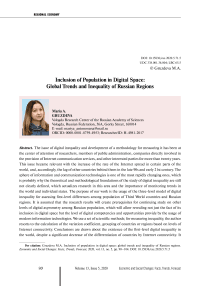Inclusion of population in digital space: global trends and inequality of Russian regions
Автор: Gruzdeva Maria A.
Журнал: Economic and Social Changes: Facts, Trends, Forecast @volnc-esc-en
Рубрика: Regional economy
Статья в выпуске: 5 т.13, 2020 года.
Бесплатный доступ
The issue of digital inequality and development of a methodology for measuring it has been at the center of attention of researchers, members of public administration, companies directly involved in the provision of Internet communication services, and other interested parties for more than twenty years. This issue became relevant with the increase of the rate of the Internet spread in certain parts of the world, and, accordingly, the lag of other countries behind them in the late 90s and early 21st century. The sphere of information and communication technologies is one of the most rapidly changing ones, which is probably why the theoretical and methodological foundations of the study of digital inequality are still not clearly defined, which actualizes research in this area and the importance of monitoring trends in the world and individual states. The purpose of our work is the usage of the three-level model of digital inequality for assessing first-level differences among population of Third World countries and Russian regions. It is assumed that the research results will create prerequisites for continuing study on other levels of digital asymmetry among Russian population, which will allow revealing not just the fact of its inclusion in digital space but the level of digital competencies and opportunities provide by the usage of modern information technologies. We use a set of scientific methods; for measuring inequality, the author resorts to the calculation of the variation coefficient, grouping of countries or regions based on levels of Internet connectivity. Conclusions are drawn about the existence of the first-level digital inequality in the world, despite a significant decrease of the differentiation of countries by Internet connectivity. It is revealed that Russia, in comparison with other countries, shows a significant increase of the share of Internet users, and there are elements of digital divide within Russian regions even with the decrease of variation coefficients. The scientific novelty of the study is the assessment of the scale and dynamics of the first-level digital inequality among population at the country and regional levels, grouping of countries, and Russian regions by the share of Internet users and the usage of mobile devices to access the network.
Information and communication technologies, territorial digital inequality, internet connectivity, levels of digital inequality, technological and economic factors of digital inequality, Russia
Короткий адрес: https://sciup.org/147225497
IDR: 147225497 | УДК: 338.001.36.004 | DOI: 10.15838/esc.2020.5.71.5
Текст научной статьи Inclusion of population in digital space: global trends and inequality of Russian regions
Modern world is on the threshold of the fourth industrial revolution, which is based on new digital, biological, physical, and other types of technologies. In this regard, scientific and public discourse more often uses terms that, in one way or another, characterize the impact of new digital technologies on the economy and society. Over the twenty-year history of using the terms “Internet economy”, “digital economy”, and its derivatives, they still have not acquired clear outlines, which, however, does not prevent their widespread usage in business environment, media, scientific publications, and other sources [1]. Indeed, it is quite difficult to delineate and make generally accepted boundaries of something that undergoes constant changes. Rapid development of modern digital technologies does not allow us to clearly “stabilize” the manifestations of their impact on the economy and society: if in the initial period direct access to information and communication technologies (ICTs) was of primary importance, now, when the Internet and other means of ICT became integral part a daily life of the majority of the world’s population, the question of how and for what purposes these technologies are produced and used becomes more urgent.
Without a doubt, the introduction of digital technologies varies in different regions of the world, countries and within them, which is also related to the level of development strategy, technical capabilities and population’s sensitivity to changes. Inequality of population’s access to digital services and different opportunities for its usage, caused by many reasons, from material ones to availability of skills and motivation, put at the forefront new and barely studied aspects of social inequality. It may cause social exclusion of social and demographic groups from digital development processes. This sets new research tasks, which is partly what this work is devoted to. This is also stated in numerous foreign and domestic scientific papers [2–7]. The “leaders” of scientific research in this area in Russia are representatives of the “Higher School of Economics”, who proposed methodological tools for assessing the contribution of the Internet economy to GDP [8], a composite indicator for measuring the size and dynamics of digital inequality in Russia [9], and other methods. They launched a statistical study of the digital economy in Russia1 and emphasized that the changes, which take place in society within the transition to the digital economy, are still insufficiently studied and require development and usage of new indicators, approaches, and methods. It determined the relevance of the research.
The purpose of work is the application of the three-level digital inequality model to assess the first-level differences among population of different countries and Russian regions. To achieve this goal, the following objectives were set and implemented: theoretical and methodological approaches to the study of digital inequality were considered; trends of digital development in the world, developed and developing countries, and Russia were analyzed; the scale of unevenness of the world’s countries and Russian regions in terms of Internet spread and usage was assessed; the studied objects were grouped by levels of digital development.
The scientific novelty of the study is the assessment of the scale and dynamics of the first-level digital inequality among population at the country and regional levels, grouping of different countries and Russian regions by the share of Internet users and the usage of mobile devices for accessing the network.
Materials and methods
The research uses a set of scientific methods, in particular comparative analysis, statistical analysis, and sociological methods to achieve its goals and objectives. The theoretical basis is scientific works that study the formation, development and methods of assessing the digital economy and digital inequality.
To measure global trends of digital development, data on a number of Internet users, landline and mobile phone subscribers, and Internet subscriptions, including mobile, published by the International Telecommunication Union (hereinafter – ITU) are used, since its sufficiency for showing overall distribution situation. To properly assess the scale of first-level digital inequality, data on the share of population using the Internet are considered.
The variation coefficient is used for measurement. Its values allow assessing the presence and scale of differences between regions and countries for a particular indicator within the following borders:
-
< 17% – aggregate is absolutely homogeneous;
-
17–33% – aggregate is fairly homogeneous;
35–40% – aggregate is not homogeneous enough;
40–60% – aggregate is significantly heterogeneous;
-
> 60% – aggregate is absolutely heterogeneous.
In order to study the distribution of countries by Internet penetration, we used a grouping of statistical data with closed intervals and identified three levels of it – above average, average, and below average.
In each case, the study period is limited by the availability of statistical data. For international data, this is 2001–2019. For the Russian Federation, the collection of most indicators (with the exception of ITU observations on the share of Internet users, which included almost all countries of the world) was started relatively recently, rather than in world statistics, in 2013 (analyzed until 2018). For Russian regions, the available information is collected for 2016, 2017, and 2018.
The research is based on official data from the International Telecommunication Union and collections of statistical indicators published jointly by Rosstat and NRU “Higher School of Economics”: “Indicators of the digital economy”, “Information society in the Russian Federation”, and “Information society: Main characteristics of entities of the Russian Federation”.
Results
Modern researchers of digital inequality agree, first, on the need to study it and create methodological foundations for its assessment, and, second, that it has a differentiated structure.
Initially, the approach to analyzing digital inequality was studied mainly in a geographical discourse, between countries that have and do not have access to the introduction of information and communication services, conditionally rich and poor [10; 11]. However, almost immediately, the scientific community came to the conclusion that these processes are more multifaceted and are not based only on access to ICTs, and, in this regard, several levels of digital inequality were identified. In 2001, E. Hargittai proposed a theory of two types of digital inequality: the first one shows unequal chances in accessing ICTs, and the second one is characterized directly by differences in the specifics of Internet usage. It was assumed that the second type of inequality is possible with more widespread penetration of ICTs into people’s daily lives [12; 13].
It laid the foundation for the study of digital inequality from various fields of knowledge – sociology, economics, political science, media environment, marketing [14]. Foreign and domestic researchers considered various factors of unequal access to and usage of ICTs related to differences in incomes2 [15], education level [16, 17, 18], age [19], gender3 [20], and so on.
Currently, a theory of three levels of digital inequality is being developed, which has become the basis for a comprehensive study of the digital divide from a person’s point of view [4; 21; 22]. According to it, the digital divide can manifest itself on three main levels: 1) the level of population’s access to the Internet and other ICTs; 2) the level of digital competence of users and digital literacy; 3) the level of social benefits that users receive when using digital technologies correctly and fully in their professional and private lives.
Without using such terminology but studying the same characteristics of digital stratification of society, researchers from Ulyanovsk O.V. Shinyaeva, O.V. Poletaeva, O.M. Slepova [23] search for efficient practices of population adaptation to it, study the motivation of population to adapt to changes in order to increase their own efficiency in the digitalization era.
After studying the rich experience of publications on digital inequality, we remain in solidarity with the positions of modern researchers about the versatility and complexity of this phenomenon, the need to build effective methods for measuring it. Our study is based on a three-level model of the digital divide, which is common for foreign works (one of outstanding representatives of the direction is Massimo Ragnedda), and it develops in Russia (scientific school of NRU HSE – M.Y. Arkhipova, V.P. Sirotin; MSU University – A.A. Gladkova; Kazan Federal University – V.Z. Garifullin; Ulyanovsk State University – A.R. Safiullin, O.A. Moiseeva; Institute for Social and Economic Research at Ufa Research Center of RAS – D.A. Gainanov, T.F. Sharifiyanov).
Most of the discussion will focus on the first level of inequality in the availability and usage of ICTs by population; data on the reasons for non-usage of the Internet in households will be partially affected. The second and third levels of inequality, namely, the characteristics of development of digital competencies and
Figure 1. Global trends of digital development (average across countries), number per 100 residents
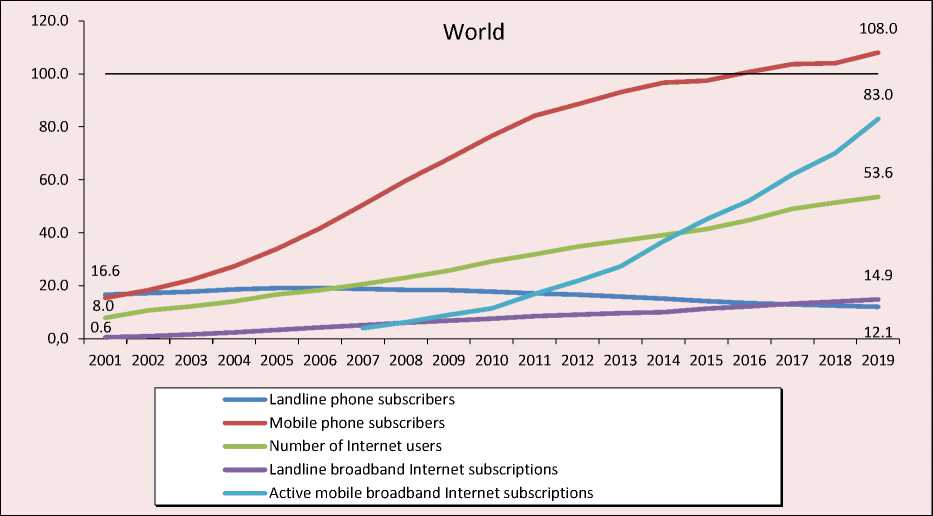
Source: ITU world telecommunication indicators database. Available at:
Hereafter, a number of mobile cellular subscribers with data access (for example, the Internet) at a broadband transmission rate in a direct channel (hereafter defined as exceeding or equal to 256 Kbit/s).
benefits, received by active users, can be studied in depth and qualitatively only if there is a significant and, preferably, monitoring database of sociological studies. According to a number of scientists, the lack of such data is a limiting factor for comprehensive studies of the digital divide [4]. An in-depth study of the second and third levels of digital inequality with a case study of population from a specific region (namely, settlement, socio-demographic, socioeconomic, and other aspects) is the prospect of our future work.
Assessment of the digital divide in the world
In general, global trends of ICT development in the world can be characterized by a desire for mobility: everywhere, a number of landline phone subscribers decreases, and a number of mobile phones rapidly grows. On average, a number of mobile subscribers in the world has exceeded 100 units per 100 people since 2016, that is, part of population needs access to mobile network from more than one device (in 2001–2019, the value increased by 7 times, the annual growth rate of 36.7% per year; fig. 1).
The history of the emergence and usage of the Internet dates back to the 60s of the 20th century, but it took no more than 30 years before it became a satellite of an average person. Significant mass individual usage of the World Wide Web can be seen since the late 1990s and early 2000s: it is when ITU began monitoring shares of users. Since then, Internet spread into everyday life and business processes continued at a significant pace, but there is still potential for growth: according to preliminary ITU estimates, in 2019, one out of two people on Earth used the Internet (or 53.6 people out of 100). The same trend is observed here – mobile Internet is more widespread than landline access (in 2019, a number of active mobile Internet subscriptions were 5.5 times higher than a number of landline subscriptions; in each case, it is about broadband Internet with a data transfer rate of 256 Kbit per second or higher)4.
The direction of trends of ICT usage in developed and developing countries is similar ( Fig. 2, 3 ), but the scale remains different.
In developed countries, all indicators of digital development were higher at the initial stage of mass individual (for personal purposes) usage of the Internet (since the beginning of the
2000s), but this situation still persists. A number of mobile network users began to exceed population in 2007, and, over 2001–2019, the indicator value increased by 2.7 times or by 14.4% annually. In developed countries, more than 86% of population uses the Internet, and mobile broadband Internet is more in demand than landline Internet (in 2019, a number of mobile Internet subscriptions exceeds a number of landline subscriptions by 3.4 times). It means that users strive to ensure constant access to the network regardless of their location.
In regard to developing countries, it is possible to mention even more significant growth rates, especially in recent years. In the early 2000s, the positions of developed and
Figure 2. Trends of digital development in developed countries (average for developed countries), number per 100 residents
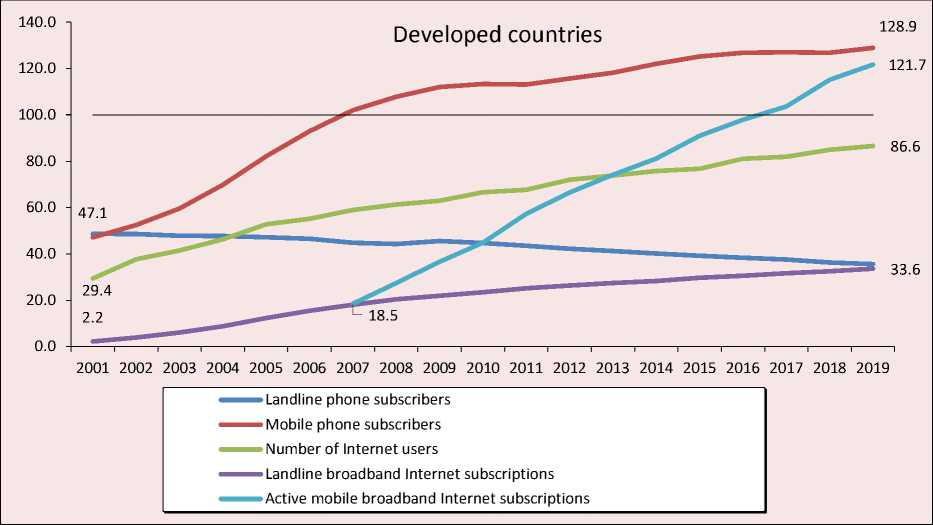
Source: ITU world telecommunication indicators database. Available at:
Figure 3. Trends of digital development in developing countries (average for developing countries), number per 100 residents
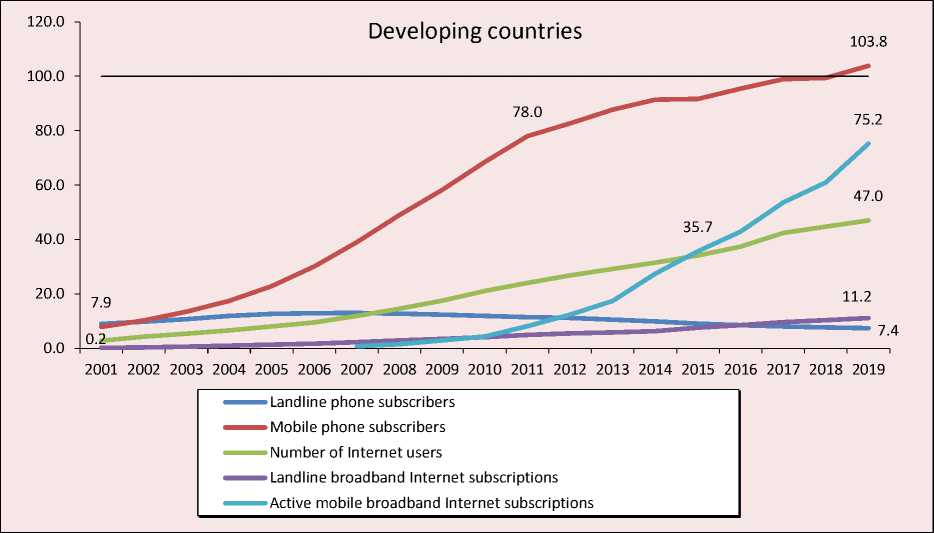
Source: ITU world telecommunication indicators database. Available at:
developing countries were different: in the former ones, the involvement of population was very high (probably due to the sufficient standard of living and education for the introduction of innovations), in the latter ones – minimal. However, the rate of Internet spread is higher in developing countries. In 2001–2019, a number of mobile subscribers increased by 13 times or 69% on average annually. One out of two people in developing countries use the Internet: 75 out of 100 of them are mobile, and only 11 out of 100 are stationary.
In Russia, detailed statistics on the introduction of digital technologies into people’s daily lives began to be collected much later. Data have been published since 2013. Over a six-year period, we can see the same trends that occurred in the world: the decline of a number of landline phone subscribers and the growth of mobile network and broadband Internet users (Fig. 4). According to almost all indicators, in general, Russia is closer to developed countries according to digital development trends with the exception of a small number of mobile network subscribers (compared to the leaders of digital development).
Due to statistical measurements of the International Telecommunication Union, it is possible to estimate the scale of first-level digital inequality in the world. The share of Internet users increases everywhere: on average, it grew by 43.6 p. p. in 2002–2019, by 42.6 percentage points in developing countries, and by 52 percentage points in developed countries ( Fig. 5 ). In Russia, the share of Internet users also increased rapidly – by 76 p. p. during the studied period.
Figure 4. Trends of digital development in Russia, number per 100 residents
120.0
100.0
80.0
60.0
40.0
20.0
Russia

0.0
2013 2014 2015 2016 2017 2018
Landline phone subscribers
Mobile phone subscribers
^^^^^™ Landline broadband Internet subscriptions
Active mobile broadband Internet subscriptions
Source: Information Society in the Russian Federation. 2018, 2019: Stat. Coll.
Figure 5. Share of people using the Internet, %
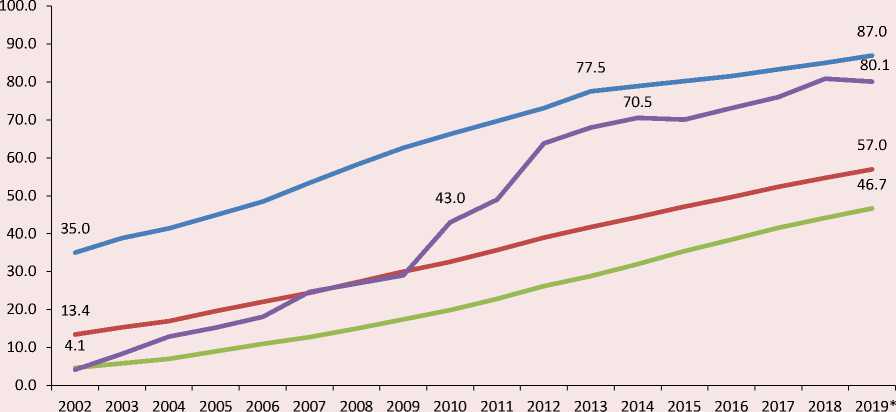
^^^^^™ Developed countries ! Whole world Developing countries ■ Russia
* 2019 – preliminary estimates.
Source: ITU world telecommunication indicators database. Available at:
2010 is a turning point for digital development of the Russian Federation. It is the year when the share of Internet users exceeded the global average. Before 2009, Russia was closer to developing countries in terms of population involvement in Internet usage, but, since 2010, it has been closer to developed countries ( Fig. 6 ). At the moment, it does not differ from developed countries in terms of population involvement in the usage of the Internet.
The scale of first-level digital inequality in the world decreases. When studying the percentage of people who use the Internet, it was revealed that the variation coefficient decreased by more than 65%. However, total number of countries in the world in terms of Internet spread remains heterogeneous: in 2017, values range from the minimum in East Africa and Eritrea (1.3%) to the maximum in Kuwait (100%; tab. 1).
In order to understand digitalization processes in the world, the countries were grouped by three levels of Internet spread, and the change of Russia’s position in the proposed classification was analyzed.
Over the entire period, the top five countries with the largest share of Internet users were European countries, including the territories of Great Britain outside of its borders (for example, Bermuda, the Falkland Islands). A number of European microstates (Andorra, Luxembourg, and Liechtenstein) were in the leading group due to small population number ( Tab. 2 ). Since 2016, Gulf countries are also
Figure 6. Dynamics of the variation coefficient for the indicator “Share of people using the Internet” between Russia, developed and developing countries, %
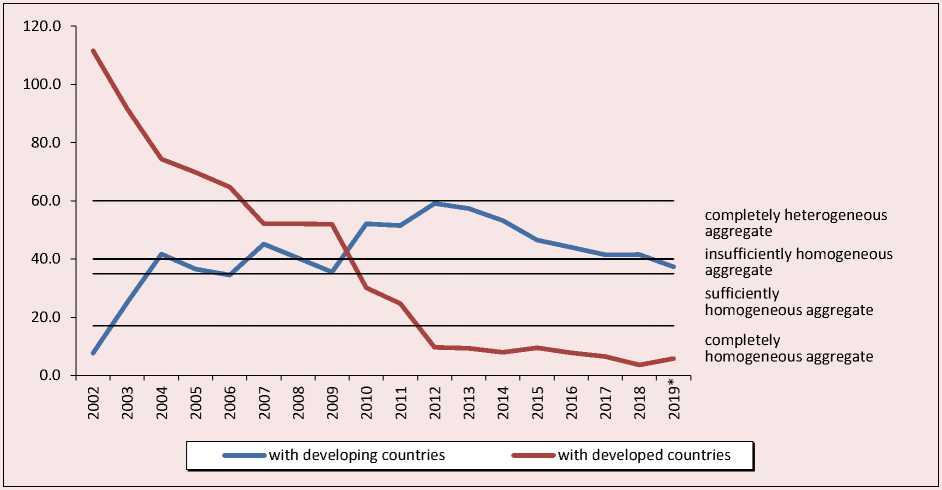
* 2019 – preliminary estimates.
Source: ITU world telecommunication indicators database. Available at:
Table 1. Variation of the indicator “Share of people using the Internet” in different countries
Indicator 2000 2005 2010 2011 2012 2013 2014 2015 2016 2017 Growth rate, 2017 to 2000, % Maximum value 58.6 87.0 95.8 96.4 96.9 96.9 98.2 98.3 99.0 100.0 70.6 Minimum value 0.0059 0.0652 0.2500 0.7000 0.8000 0.9000 0.9900 1.0837 1.1771 1.3089 221 times Variation coefficient 146.1 107.5 78.6 73.4 70.2 67.7 63.1 58.5 56.1 50.8 -65.2 Source: ITU world telecommunication indicators database. Available at:
Table 2. Russia’s position in the grouping of countries according to the indicator “Share of people using the Internet”
Level 2000 2005 2010 2012 2013 2014 2015 2016 2017 Above average Norway Canada San Marino New Zealand Switzerland Iceland Sweden Denmark Norway Netherlands Iceland Norway Netherlands Luxembourg Sweden Iceland Norway Sweden Netherlands Denmark Iceland Norway Sweden Denmark Andorra ... Russia Iceland Norway Denmark Andorra Liechtenstein ... Russia Iceland Andorra Norway Liechtenstein Luxembourg ... Russia Iceland Luxembourg Liechtenstein Bahrain Andorra ... Russia Kuwait Iceland Liechtenstein Qatar Luxembourg ... Russia Average Finland Liechtenstein Singapore Ascension island Austria Greenland Hong Kong China Belgium Monaco Slovakia Greenland Malta Saint Kitts and Nevis Poland Lithuania ... Russia Saint Kitts and Nevis Russia Poland Croatia Kazakhstan Trinidad and Tobago Antigua and Barbuda Kazakhstan Poland Portugal Saudi Arabia Argentina Portugal Malaysia Greece Uruguay French Polynesia Venezuela Puerto Rico Albania Armenia Dominican Republic Jordan Italy Palestine Palestine Guatemala Bosnia and Herzegovina Armenia Turkey Below average Russia ... Sudan Somalia Liberia Ethiopia Republic of Congo Russia ... Niger Ethiopia Sierra Leone East Timor Myanmar Ethiopia Congo Eritrea Sierra Leone Myanmar Eritrea Niger Burundi Somalia Congo Eritrea Niger Burundi Somalia Congo Eritrea Niger Burundi Somalia Chad Guinea Bissau Chad Niger Somalia Eritrea Niger Central African Republic Guinea Bissau Somalia Eritrea Central African Republic Guinea Bissau Burundi Somalia Eritrea Source: ITU world telecommunication indicators database. Available at: Grouping is conducted by the author according to data on 207 countries, published by ITU, each group includes 5 countries and Russia. Ranked: above average and average levels – in descending order, the countries with the highest shares of people using the Internet. Below average – in ascending order, countries with the lowest proportion of Internet users.
included in this list, the economy of which is based on oil production – Bahrain, Kuwait, and Qatar, where oil and gas made it the first country in terms of GDP per capita in the world.
As for the group of countries with the lowest proportions of Internet users, there is also some stability. Over the last 18 years, African countries have been at the bottom of the rating, and the situation there remains mostly unchanged – Internet connectivity is still minimal.
Based on the grouping of countries, there is also a significant rate of Internet entry into lives of Russian citizens: if Russia was included, along with African countries, in the group with below-medium spread in the early 2000s (in 2000, only 2% of population used the Internet), then it moved to the medium level in 2010, entered the top five within this group in 2012, and began to develop at the same pace as developed countries. At the moment, it is part of a group of states with a higher-than-medium level of the Internet usage.
Assessment of digital inequality in Russian regions
Russian regions are characterized by disproportions in development according to various aspects. This issue is successfully studied within the regional economy. Main causes of inequality include a whole complex of natural and artificial factors and conditions. Based on this, an assumption exists that there is also an asymmetry in the processes of using ICT. While testing this hypothesis, we analyzed the materials, statistical compilations, published by Rosstat together with NRU HSE, which allowed studying the differentiation of Russian regions by the share of households with Internet access (on average, without specifying landline or mobile connection) and the proportion of population who use mobile devices, including smartphones and other gadgets, to access the network. The analysis of these data helps to assess the scale of first-level digital inequality in the country, as well as indirectly track how the population corresponds to global trends related to the predominance of mobile Internet over landline access. It needs to be mentioned that the calculation of variation indicators allows us to judge the average convergence of regions by Internet spread and by using it from mobile devices (the variation coefficient in both cases indicates absolute and sufficient uniformity of regions, tab. 3 ).
However, if we consider values of indicators, the result is somewhat different. For example, in the Chechen Republic in 2018, only one out of two people had access to the network (50.2%, tab. 4 ), which corresponds to the level of developing countries, and, in the region with a high level of spread – the Republic of Buryatia, the value at the level of developed countries was recorded – more than 87%.
In this case, it is difficult to link the grouping of regions with trends of its socio-economic development, since leaders and outsiders change, and the growth of a number of users is not always shown. On the contrary, a significant decrease (not corresponding to the increase of population, which could affect relative indicators) was recorded in a number of regions. Among them are the Republic of Dagestan and the Chechen Republic (which had the decrease by 17 and 25 p. p. in 2018 compared to 2017, respectively), the Republic of Sakha, Tyva, Kalmykia, and Krasnodar Krai (which lost from 15 to 30 p. p. in the share of Internet users). The reasons for such trends may include inaccuracies in static accounting and infrastructure aspects (for example, unfavorable conditions for using landline Internet and the lack of access to it, or poor quality of mobile Internet).
A similar situation is recorded in relation to the usage of mobile devices. The variation is
Table 3. Variations of Internet usage indicators in Russian regions
|
Indicator |
2016 |
2017 |
2018 |
Growth rate, 2018 to 2016, % |
|
Share of households with Internet access |
||||
|
Maximum value |
88.6 |
88.1 |
87.4 |
-1.4 |
|
Minimum value |
61.6 |
62.1 |
50.2 |
-18.5 |
|
Variation coefficient |
7.6 |
7.4 |
10.0 |
31.6 |
|
Share of mobile devices usage (mobile phones or smartphones, e-book readers, etc.) for accessing the Internet |
||||
|
Maximum value |
70.5 |
79.3 |
n.d. |
12.5 |
|
Minimum value |
22 |
37 |
n.d. |
68.2 |
|
Variation coefficient |
22.2 |
16.2 |
n.d. |
-27.0 |
|
Source: own calculations; Information Society in the Russian Federation. 2018, 2019: Stat. Coll. |
||||
Table 4. Grouping of Russian regions by share of households with Internet access
|
Level |
2016 |
2017 |
2018 |
|
Above average |
Saint Petersburg Chukotka AO Magadan Oblast Republic of Ingushetia Kaliningrad Oblast |
Republic of North Ossetia–Alania Saint-Petersburg Magadan Oblast Republic of Ingushetia Tuvan Republic |
Republic of Buryatia Saint-Petersburg Altai Republic Tyumen Oblast Republic of North Ossetia–Alania |
|
Average |
Tula Oblast Republic of Karelia Moscow Oblast Kamchatka Krai Voronezh Oblast |
Krasnodar Krai Primorsky Krai Sakhalin Oblast Kaliningrad Oblast Republic of Kalmykia |
Orenburg Oblast Republic of Karelia Tambov Oblast Irkutsk Oblast Chelyabinsk Oblast |
|
Below average |
Nizhny Novgorod Oblast Vologda Oblast Ryazan Oblast Tomsk Oblast Republic of Buryatia |
Republic of Mordovia Yaroslavl Oblast Chuvash Republic Ulyanovsk Oblast Kirov Oblast |
Republic of Kalmykia Chukotka AO Republic of Dagestan Tuvan Republic Chechen Republic |
|
Source: Information Society in the Russian Federation. 2018, 2019: Stat. Coll. Grouping is conducted by the author according to data on 85 entities of the Russian Federation, each group includes 5 regions. Ranked: above average and average level – in descending order, regions with the highest percentage of Internet users. Below average level – in ascending order, regions with the lowest share of Internet users. |
|||
Table 5. Grouping of Russian regions by the share of mobile devices (mobile phones or smartphones, e-book readers, etc.) for accessing the Internet
Thus, digital development of Russian regions is uneven; some areas have development level which could be compared only to developing countries, while others have already exceeded the level of developed countries. It once again exposes differentiation problems in Russian regions by a set of characteristics. Application of personal (individual) and environmental (regional) determinants to this cross-section will allow studying settlement (city/village), sociodemographic, and socio-economic aspects of digital inequality. The reasons for digital inequality are the lack of infrastructure development, socio-cultural characteristics of regions, differences in living standards, and the availability of population’s digital competencies. This information is expected to be studied in detail in the future while assessing the second and third levels of inequality.
Conclusion
The conducted research made it possible to draw several conclusions. It is revealed that, despite a significant decrease of countries’ differentiation in terms of Internet connectivity, there is first-level digital inequality in the world, and its scale is large. A number of countries and regions of the world do not have access to the Internet – it is one of the newest manifestations of social inequality. For example, over the past 18 years, the situation with the internetization of Africa (with the exception of Egypt, South Africa, and Morocco) has remained mostly unchanged, where the share of users does not exceed 2% of population. Countries with a high involvement of residents in the Internet usage are represented mainly by European states. Since 2016, the oil-producing countries of the Persian Gulf have also began to join them, which confirms the importance of the economic determinant of digital development (its infrastructure component at least).
While comparing digitalization trends in developed and developing countries, it is concluded that they have a common focus: active Internet spread rates, reorientation to wireless communications and the Internet. Without a doubt, ICT is used more often in developed countries, but developing countries experience rapid growth of network access.
It is revealed that Russia also shows a significant increase of the share of Internet users: global average level was exceeded in 2010, and, if the country was among a group of countries with below average indicators, along with African countries, and its informatization growth approached the level of developing countries in the early 2000s, then, since 2010, it have got closer to developed countries.
The calculation of variation among Russian regions does not show any striking differences in the usage of the Internet by its population. At the same time, there are elements of first-level digital divide: in some regions, only one out of two people uses the Internet, in other areas – only one out of eight or nine people. There are territories with the decrease of the share of Internet users.
Russian regions also lag behind in terms of mobile Internet adoption rates: in 31 regions, the share of access to the network via mobile phones and other gadgets does not exceed 52%, and in 39 more – 65%. At the same time, wireless Internet is more accessible in material terms (average cost of mobile devices is reduced, its purchase is cheaper than buying a personal computer, and mobile operators’ offers are also more profitable for mobile Internet than access via a desktop computer/ laptop). The main problem is a technical one: for example, the mobile network is much more accessible for rural residents from an economic point of view, but, in some areas, there is either no access to it, or it is difficult due to poor connection quality. It may be a factor of its exclusion from the digital environment and, moreover, manifestation of social exclusion.
The results of the study will serve as the basis for further study of population’s digital inequality within the three-level model with a case study of Russia and within a single region (Vologda Oblast); in particular, it is proposed to study the differences in settlements (large towns, constituting two opposite poles of development of the region’s business and cultural capital and industrial center, municipalities, rural areas) and differences determined by age, gender, level of education, income and sociocultural characteristics of a ICT user, and digital services.
The research topic is multidisciplinary; it attracts the attention of specialists from the media sphere, mass media, philosophy, philology, economics, sociology, etc. The results of conducted and future studies on this topic are at the intersection of regional economics (the study of regional development factors, including socio-cultural ones) and sociology (the study of adaptation, motivation and changes of population’s behavior in relation with the spread of digital services). The materials of the work are relevant information basis for assessing the digital divide among population in the world and Russia in particular, which can be used as a basis for conducting research on digital development as part of teaching in higher school. Also, it may be used as a basis for making management decisions, developing strategic programs by regional and federal authorities to reduce all manifestations of social inequality of population without exceptions, including ones occurring during the implementation of the national project “Digital economy”.
Список литературы Inclusion of population in digital space: global trends and inequality of Russian regions
- Ganichev N.A., Koshovets O.B. Quantifying the Digital Economy: Between Reality and Design. EKO=ECO, 2020, no. 2, pp. 8–36. DOI: 10.30680/ECO0131-7652-2020-2-8-36 (in Russian).
- Dubinina M.G. Unequal development of the digital economy in federal districts of Russia. Upravlenie naukoi i naukometriya=Science Governance and Scientometrics, 2019, vol. 14, no. 3, pp. 368–399. DOI: 10.33873/2686-6706.2019.14-3.368-399 (in Russian).
- Volchenko O.V. Dynamics of digital inequality in Russia. Monitoring obshchestvennogo mneniya: ekonomicheskie i sotsial’nye peremeny=Monitoring of Public Opinion: Economic and Social Changes, 2016, no. 5, pp. 163–182. DOI: 10.14515/monitoring.2016.5.10 (in Russian).
- Gladkova A.A., Garifullin V.Z., Ragnedda M. Model of Three Levels of the Digital Divide: Current Advantages and Limitations (Exemplified by the Republic of Tatarstan). Vestnik Moskovskogo universitet. Seriya 10. Zhurnalistika=Vestnik Moskovskogo universiteta. Seriya 10. Zhurnalistika, 2019, no. 4, pp. 41–72 (in Russian).
- Nieminen H. Digital divide and beyond: What do we know of information and communications technology’s long-term social effects? Some uncomfortable questions. European Journal of Communication, 2016, vol. 31(1), pp.19–32. DOI: https://doi.org/10.1177/0267323115614198
- Ragnedda M. Conceptualizing digital capital. Telematics and Informatics, 2018, vol. 35, pp. 2366–2375. DOI: https://doi.org/10.1016/j.tele.2018.10.006
- Ragnedda M., Kreitem H. The three levels of digital divide in East EU countries. World of Media. Journal of Russian Media and Journalism Studies, 2018, vol. 4, pp. 5–27. DOI: 10.30547/worldofmedia.4.2018.1
- Plaksin S., Abdrakhmanova G., Kovaleva G. Approaches to defining and measuring Russia’s internet economy. Foresight and STI Governance, 2017, vol. 11, pp. 55–65. DOI: 10.17323/2500-2597.2017.1.55.65
- Arkhipova M.Yu., Sirotin V.P., Sukhareva N.A. Development of a composite indicator for measuring the value and dynamics of digital inequality in Russia. Voprosy statistiki=Voprosy statistiki, 2018, no. 25(4), pp. 75–87 (in Russian).
- Norris P. The Digital Divide: Civic Engagement, Information Poverty, and the Internet Worldwide. Cambridge, UK: Cambridge University Press, 2001. 320 p. DOI: https://doi.org/10.1017/CBO9781139164887
- Attewell P. The first and second digital divides. Sociology of Education, 2001, vol. 74 (3), pp. 252–259.
- Hargittai E. Second-level digital divide: mapping differences in people’s online skills. In: 29th TPRC Conference, 2001. Available at: https://arxiv.org/abs/cs/0109068
- DiMaggio P., Hargittai E. From the «digital divide» to «digital inequality»: Studying Internet use as penetration increases. Working Papers from Princeton University, 2001, no. 47.
- Vartanova E.L. Conceptualization of digital divide: Major stages. MediaAl’manakh=MediaAlmanah, 2018, no. 5, pp. 8–12. DOI: 10.30547/mediaalmanah. 5.2018.812 (in Russian).
- Polozhikhina M.A. Information and digital inequality as a new type of socio-economic differentiation of society. Ekonomicheskie i sotsial’nye problemy Rossii=Economic and Social Problems of Russia, 2017, no. 2, pp. 119–141 (in Russian).
- Alam S.S., Abdullah Z., Ahsan N. Cyber café usage in Malaysia: An exploratory study. Journal of Internet Banking and Commerce, 2009, vol. 14 (1), pp. 1–13.
- Avila A. Underdeveloped ICT areas in Sub-Saharan Africa. Informatica Economica, 2009, vol. 13 (2), pp. 136–146.
- Shinyaeva O.V., Slepova O.M. Information Digital Inequality of Population: Risk and Anti-Risk Factors. Izvestiya Saratovskogo universiteta. Novaya seriya. Seriya: Sotsiologiya. Politologiya=Izv. Saratov Univ. (N. S.), Ser. Sociology. Politology, 2019, vol. 19, no. 1, pp. 53–61. DOI: https://doi.org/10.18500/1818-9601-2019-19-1-53-61 (in Russian).
- Israelashvili M., Kim T., Bukobz G. Adolescents’ over-use of the cyber world – Internet addiction or identity exploration? Journal of Adolescence, 2012, no. 35 (2), pp. 417–424.
- Davaki K. The Underlying Causes of the Digital Gender Gap and Possible Solutions for Enhanced Digital Inclusion of Women and Girls. 2018. 53 p. Available at: http://www.europarl.europa.eu/RegData/etudes/STUD/2018/604940/IPOL_STU(2018)604940_EN.pdf
- Ragnedda M. The Third Digital Divide: A Weberian Approach to Digital Inequalities. UK Routledge. 2017. 128 p.
- Ragnedda M. Conceptualizing digital capital. Telematics and Informatics, 2018, no. 35, pp. 2366–2375. DOI: https://doi.org/10.1016/j.tele.2018.10.006
- Shinyaeva O.V., Poletaeva O.V., Slepova O.M. Information and digital inequality: searching for effective population adaptation practices. Monitoring obshchestvennogo mneniya: Ekonomicheskie i sotsial’nye peremeny=Monitoring Public Opinion: Economic and Social Changes, 2019, no. 4, pp. 68–85. DOI: https://doi.org/10.14515/monitoring.2019.4.04 (in Russian).

